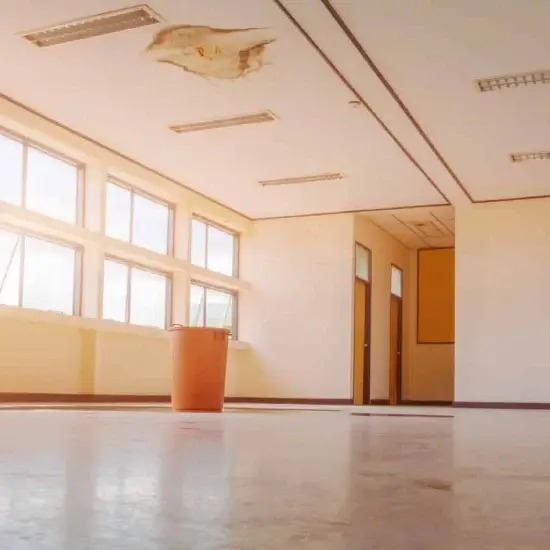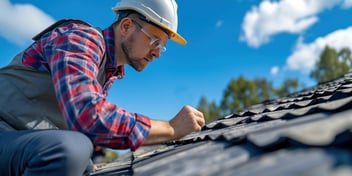- Home »
- Learningcenter »
- What do you do when your roof is leaking
What do you do when your roof is leaking?

Is a roof leak an emergency?
When it rains, it can pour, especially when you have a leaking roof. There are several things that a homeowner dreads, among them are the mortgage payment, insurance premiums, and property taxes. Those are all necessities unfortunately with homeownership. What isn’t a necessity but is a likelihood is termite infestation and a leaking roof.
As a homeowner, any size of a leaking roof may seem like an emergency, but when is a leak in roof of house really an emergency? Obviously, if the rain is profusely pouring in, it would be considered an emergency. Or if a part of your roof has been damaged or removed during a storm, that would be a leaking roof emergency. Other examples of an emergency leaking roof would be:
- Large Area of Missing Shingles: When you see a large area or several missing shingles, the damage at that moment may not seem like an emergency if there isn’t leaking roof at that moment. However, if the issue isn’t addressed with repairs being completed, it could become a bigger problem and bigger emergency later.
- Roof Decking Rotted: Rotting roof decking is a situation that should be deemed an emergency. Wood rot is typically caused by moisture. In a roof, that wood rot and moisture can from inadequate ventilation, or a leaking roof. Once a roof decking begins to rot, it has put your home’s entire structure in jeopardy.
- Your Home is Exposed to the Weather: It may be just a few shingles in one area, a massive hole, or the entire roof is gone that is leaving your home’s interior exposed to the weather, your leaking roof is an emergency.
Can leaking roof cause mold?
While water is a wonderful natural source, it is the enemy to your home. A leaking roof and water damage go hand-in-hand, so yes, that small drop or trickle of water coming through your ceiling will do a lot of damage in short time. Once you have a leaking roof, it will find its way into all the porous materials of your home and start creating damage.
Along with the structural damage, as the wood and other materials sit wet from the leaking roof, mold growth begins. A leaking roof isn’t only a structural issue, but it becomes a fire hazard and a health hazard too.
What do you do if your ceiling is leaking?, How do you fix a leaking roof from the inside?
Where there you have leaking roof with water dripping or trickling from your ceiling, creating a puddle on the floor, you need to take damage control steps. A start would be on the inside of your house with these steps:
- Clear the Area Inside Around the Leaking Roof: Move your belongings and furniture that you can out and away from the leaking roof. If you can’t move it, cover it with plastic tarps. This includes all clothing, electronics, rugs, etc.
- Position a Bucket Under the Leaking Roof Area: Once you have clear everything possible away and out of the area, place a plastic tarp on the floor and bucket on top of that under the leaking roof area. Punch a hole in ceiling so that any water build up is released and drains into the bucket. This will keep water from spreading over the rest of the ceiling, causing more damage.
- Find the Source of the Leaking Roof: If you can gain access to the attic, try to find the source of the leaking roof. Where the water is dripping is probably not where the leak is located. You’ll need to use a flashlight and follow the trail up the decking and rafters to see where it is coming from.
Once you find the entry point, get a piece of plywood, nails, and roofing cement. Cut the plywood so that it is approximately 2 inches bigger all the way around than the leak. With a putty knife, spread the roofing cement around the leak and then press the plywood in position and nail it in place. Then spread more roofing cement around the edges and over the nails. Remove and dispose any wet insulation. This will not be reusable after getting wet.
Once you have stopped the leaking roof from coming inside your home, call a roofing contractor and schedule an inspection and estimate. After you have received 2 or 3 estimates, file a claim on your homeowners’ insurance. In addition to knowing how do you fix a leaky roof, always keep these supplies on hand for future leaking roof emergencies.

Is leaking roof covered on homeowners insurance?
It will depend on several factors, with the main one being how your homeowner’s policy is stated. The other main factor will be what caused the leaking roof. If it is storm damage or damaged by unexpected happenings, then yes, your homeowner’s insurance is more likely to pay. If the leaking roof is because of the roof’s age, the claim will likely be denied, citing homeowner neglect as cause of leaking roof.
So, when you have a leaking roof and you wonder, “Who can fix my leaking roof?”, other than your temporary patch, call a professional roofing contractor. Make sure they are certified, insured, and licensed. If the leaking roof isn’t pouring into your home, get several quotes and compare them, asking for recent references. Call (678) 365-3138 today for your roof leak repair needs
 Call (678) 365-3138
Call (678) 365-3138
.jpg?width=352&height=352&name=roof%20leaks%20(1).jpg)

